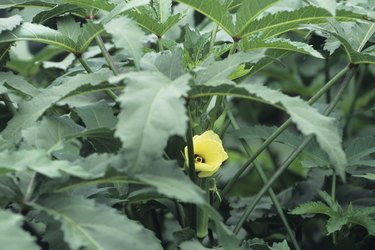
Plant okra (Abelmoschus esculentus) in your home garden to enjoy its seed pods just two months after planting. There are a variety of okra fungal diseases that may infect your plants and decrease your expected harvest. Proper care and treatment can help to save plants and prevent other problems in your home garden.
White Spots on Okra Leaves
Video of the Day
There are a couple of okra fungal diseases that may cause white leaves. Powdery mildew is a common fungal infection that causes white fuzzy patches of fungus on the leaves of the plant. Patches usually start small and increase in size, covering the entire leaf if left untreated.
Video of the Day
Overhead watering is an effective way to wash the fungus from the leaves. Be sure to remove any plant debris, as powdery mildew can survive on dead plant material over the winter. In severe cases, a fungicide spray may be needed to save the plant. Take care when using fungicides and make sure the product is labeled for use on vegetables, such as okra.
White mold is another infection that may cover the leaves in white fungus. The mold usually covers the flowers and leaves lesions on the leaves, stems and pods. However, in some cases, the white powder is also visible on the lesions. This fungus can survive for up to five years and is easily spread by wind. Be sure to rotate crops and allow plenty of space between rows to minimize the spread of the fungus.
Okra Rot Diseases
If you see black mold on okra, it may charcoal rot, which leaves black fungal fruiting bodies on the plant tissue. The rot starts at the soil line, and the infection spreads upward. If charcoal rot is a problem in your garden, be sure to rotate crops with plants that aren't susceptible to this fungus and make sure the okra is receiving enough water to remain healthy, as water-stressed plants are more likely to succumb to the disease.
Cotton root rot is also a concern for okra plants. The roots of the plant are often severely infected before the above-ground parts of the plant show symptoms, such as wilting.
Crop rotation can help reduce infection rates. Other options include amending the soil with cereal crop residues before planting and plowing the garden to a depth of 10 inches after harvest to reduce the amount of fungi that can survive the winter.
Other Okra Fungal Diseases
Southern blight is usually seen when temperatures and humidity levels are high. Symptoms include yellow and wilted leaves and browning of the stem and branches. Minimize infection by immediately getting rid of any infected plants and ensuring there is plenty of air circulation between plants. Crop rotation and plowing are also effective, long-term control strategies.
Fusarium wilt is also a concern in hotter temperatures. Symptoms include chlorosis and wilting of the leaves, stunted growth and in severe cases, plant death. Remove infected plants and use crop rotation practices to help reduce infection rates. When planting new okra plants, make sure you are using seeds that are certified disease-free.